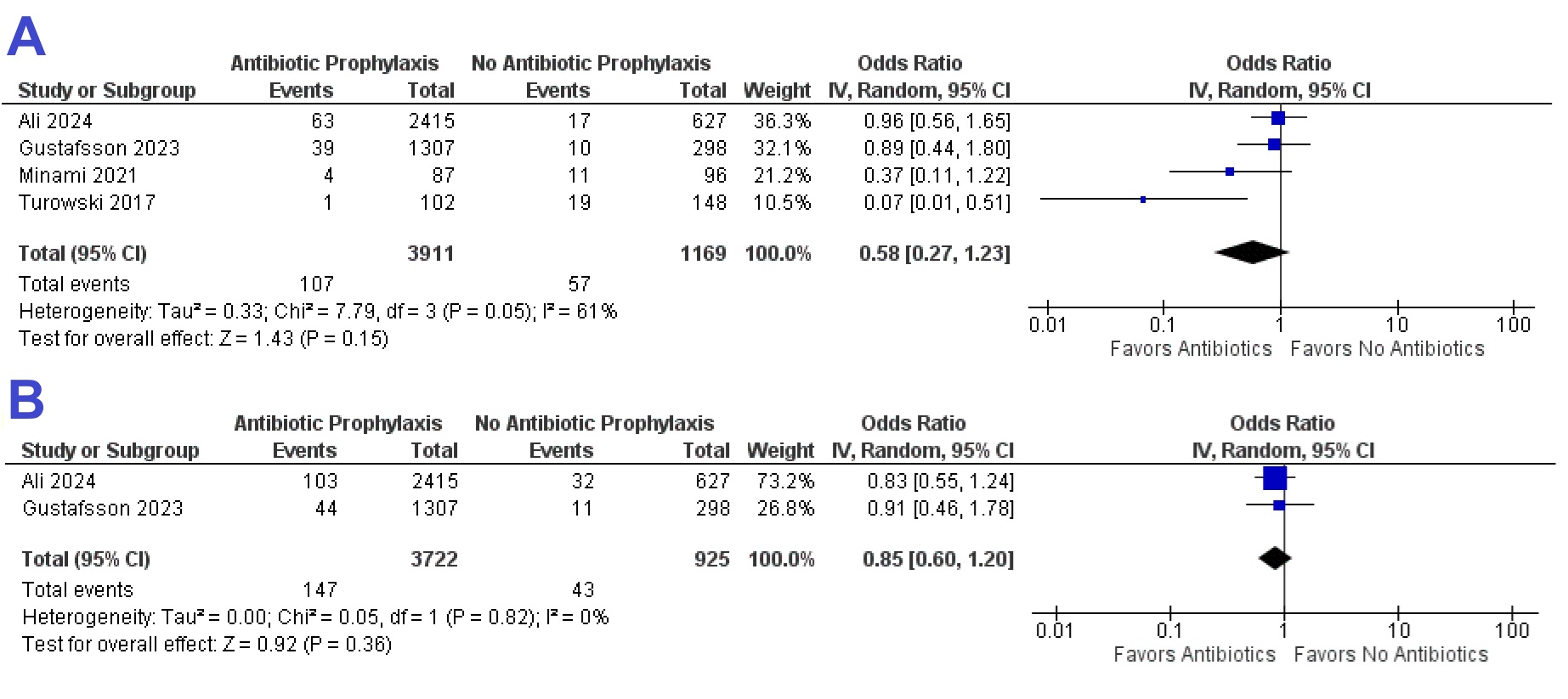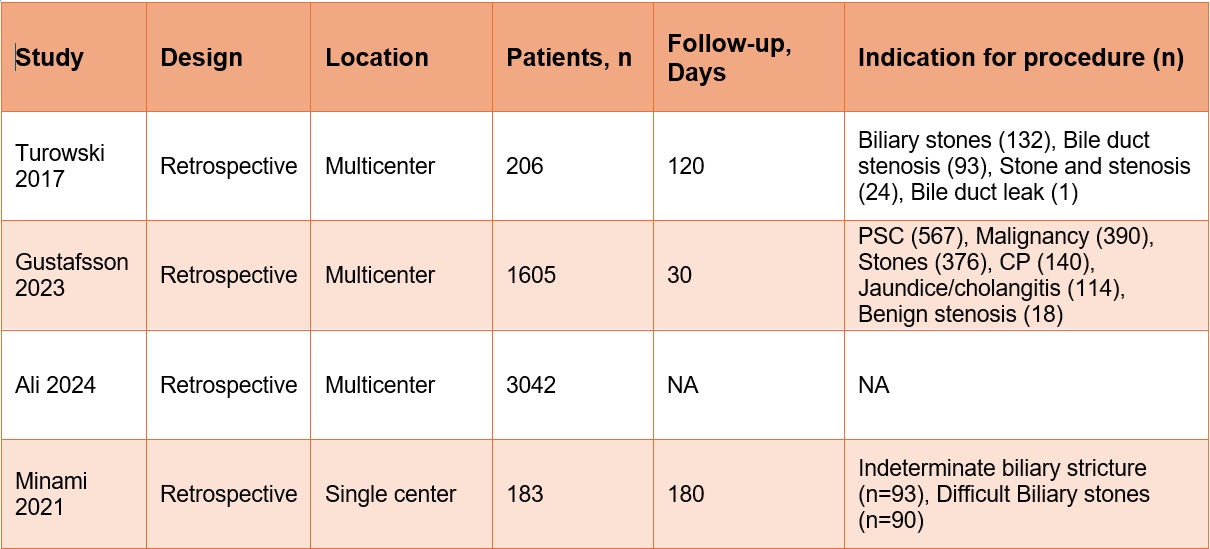Monday Poster Session
Category: Biliary/Pancreas
P2236 - Prophylactic Antibiotics and Post-Procedural Infectious Complications in Endoscopic Retrograde Cholangiopancreatography With Peroral Cholangioscopy: A Systematic Review and Meta-Analysis
Monday, October 27, 2025
10:30 AM - 4:00 PM PDT
Location: Exhibit Hall
- TA
Tareq Alsaleh, MD
Department of Internal Medicine, AdventHealth Orlando
Orlando, FL
Presenting Author(s)
Tareq Alsaleh, MD1, Baha Fawwaz, MD2, Mohamad Khaled Almujarkesh, MD2, Nouman Shafique, MD1, Bassel Dakkak, MD3, Shifa Younus, MD4, John George, MD2
1Department of Internal Medicine, AdventHealth Orlando, Orlando, FL; 2Department of Gastroenterology and Hepatology, AdventHealth Orlando, Orlando, FL; 3Marshall University Joan C. Edwards School of Medicine, Huntington, WV; 4Internal Medicine, University of Tennessee College of Medicine, Chattanooga, TN
Introduction: Single-operator peroral cholangioscopy (SOC) has been associated with higher rates of infectious complications compared to conventional endoscopic retrograde cholangiopancreatography (ERCP). Several guidelines therefore recommend antibiotic prophylaxis (AP), but the real-world impact of AP administration on infectious adverse events has been poorly studied. We conducted a systematic review and meta-analysis of studies assessing the impact of AP use on infectious complications of SOC.
Methods: A systematic review of the literature from MEDLINE, EMBASE and Scopus was conducted from inception to April 2025, for studies comparing the risk of infectious complications of SOC with and without AP. Outcomes of interest were the incidence of cholangitis and other infections following SOC. Standard meta-analysis methods were followed using the random-effects model. Treatment effect estimates were expressed as odds ratio (OR) and 95% confidence interval (CI). Heterogeneity was assessed using the I2% statistic.
Results: Four retrospective studies were included that reported on 5036 patients. Three studies were multicenter while one was single center. All the studies were from different countries. AP was used in 3911 patients, while 1169 patients did not receive AP. The most reported indication was biliary stones (n=598) (Table 1).
There was a trend towards decreased odds of post-SOC cholangitis in the AP group compared to the non-AP group. However, it was not statistically significant (OR 0.58; 95% CI [0.27,1.26], P=0.17). The odds of post-SOC infections had a slightly negative trend in the AP group but without statistical significance (OR 0.85; 95% CI [0.60, 1.20], P=0.36). These results are summarized in Figure 1.
Discussion: This meta-analysis suggests a potential benefit of AP in reducing the risk of cholangitis and other infections following SOC, although statistical significance was not achieved. The lack of significance may be due to the small number of available studies and inherent study limitations. Larger, prospective studies are warranted to better define the role of prophylaxis in minimizing infectious complications after SOC.

Figure: Table 1. Characteristics of included studies
PSC - Primary sclerosing cholangitis, CP – Chronic pancreatitis

Figure: Figure 1A. Pooled odds ratio of cholangitis following SOC with and without AP
Figure 1B. Pooled odds ratio of any infection following SOC with and without AP
Disclosures:
Tareq Alsaleh indicated no relevant financial relationships.
Baha Fawwaz indicated no relevant financial relationships.
Mohamad Khaled Almujarkesh indicated no relevant financial relationships.
Nouman Shafique indicated no relevant financial relationships.
Bassel Dakkak indicated no relevant financial relationships.
Shifa Younus indicated no relevant financial relationships.
John George indicated no relevant financial relationships.
Tareq Alsaleh, MD1, Baha Fawwaz, MD2, Mohamad Khaled Almujarkesh, MD2, Nouman Shafique, MD1, Bassel Dakkak, MD3, Shifa Younus, MD4, John George, MD2. P2236 - Prophylactic Antibiotics and Post-Procedural Infectious Complications in Endoscopic Retrograde Cholangiopancreatography With Peroral Cholangioscopy: A Systematic Review and Meta-Analysis, ACG 2025 Annual Scientific Meeting Abstracts. Phoenix, AZ: American College of Gastroenterology.
1Department of Internal Medicine, AdventHealth Orlando, Orlando, FL; 2Department of Gastroenterology and Hepatology, AdventHealth Orlando, Orlando, FL; 3Marshall University Joan C. Edwards School of Medicine, Huntington, WV; 4Internal Medicine, University of Tennessee College of Medicine, Chattanooga, TN
Introduction: Single-operator peroral cholangioscopy (SOC) has been associated with higher rates of infectious complications compared to conventional endoscopic retrograde cholangiopancreatography (ERCP). Several guidelines therefore recommend antibiotic prophylaxis (AP), but the real-world impact of AP administration on infectious adverse events has been poorly studied. We conducted a systematic review and meta-analysis of studies assessing the impact of AP use on infectious complications of SOC.
Methods: A systematic review of the literature from MEDLINE, EMBASE and Scopus was conducted from inception to April 2025, for studies comparing the risk of infectious complications of SOC with and without AP. Outcomes of interest were the incidence of cholangitis and other infections following SOC. Standard meta-analysis methods were followed using the random-effects model. Treatment effect estimates were expressed as odds ratio (OR) and 95% confidence interval (CI). Heterogeneity was assessed using the I2% statistic.
Results: Four retrospective studies were included that reported on 5036 patients. Three studies were multicenter while one was single center. All the studies were from different countries. AP was used in 3911 patients, while 1169 patients did not receive AP. The most reported indication was biliary stones (n=598) (Table 1).
There was a trend towards decreased odds of post-SOC cholangitis in the AP group compared to the non-AP group. However, it was not statistically significant (OR 0.58; 95% CI [0.27,1.26], P=0.17). The odds of post-SOC infections had a slightly negative trend in the AP group but without statistical significance (OR 0.85; 95% CI [0.60, 1.20], P=0.36). These results are summarized in Figure 1.
Discussion: This meta-analysis suggests a potential benefit of AP in reducing the risk of cholangitis and other infections following SOC, although statistical significance was not achieved. The lack of significance may be due to the small number of available studies and inherent study limitations. Larger, prospective studies are warranted to better define the role of prophylaxis in minimizing infectious complications after SOC.

Figure: Table 1. Characteristics of included studies
PSC - Primary sclerosing cholangitis, CP – Chronic pancreatitis

Figure: Figure 1A. Pooled odds ratio of cholangitis following SOC with and without AP
Figure 1B. Pooled odds ratio of any infection following SOC with and without AP
Disclosures:
Tareq Alsaleh indicated no relevant financial relationships.
Baha Fawwaz indicated no relevant financial relationships.
Mohamad Khaled Almujarkesh indicated no relevant financial relationships.
Nouman Shafique indicated no relevant financial relationships.
Bassel Dakkak indicated no relevant financial relationships.
Shifa Younus indicated no relevant financial relationships.
John George indicated no relevant financial relationships.
Tareq Alsaleh, MD1, Baha Fawwaz, MD2, Mohamad Khaled Almujarkesh, MD2, Nouman Shafique, MD1, Bassel Dakkak, MD3, Shifa Younus, MD4, John George, MD2. P2236 - Prophylactic Antibiotics and Post-Procedural Infectious Complications in Endoscopic Retrograde Cholangiopancreatography With Peroral Cholangioscopy: A Systematic Review and Meta-Analysis, ACG 2025 Annual Scientific Meeting Abstracts. Phoenix, AZ: American College of Gastroenterology.
